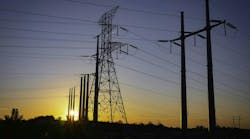The Western Area Power Administration (Western) has energized the first 20-mile segment of an 80-mile transmission line upgrade underway in Arizona and Nevada with 3M’s metal matrix, high-capacity Aluminum Conductor Composite Reinforced (ACCR).
The heat-sag-resistant conductor can carry more than twice the power of conventional steel-core lines of similar diameter, yet often does not require new or larger towers because of its relatively light weight and low sag.
3M ACCR’s strength and durability result from its core, composed of aluminum oxide (alumina) fibers embedded in high-purity aluminum, utilizing a highly specialized and patented process. The constituent materials are chemically compatible with each other and can withstand high temperatures over years of continuous operation without adverse chemical reactions or any appreciable loss in strength.
Western installed a 230-kV 3M ACCR on a line paralleling the Colorado River along Arizona’s western border with California. The area served by the line includes fast-growing communities such as Lake Havasu City and Bullhead City in Arizona; Laughlin, Nevada and Needles, California.
Western, one of four power marketing administrations within the U.S. Department of Energy, delivers about 40 billion kilowatt-hours of hydroelectric power annually in 15 western and central states. It serves some 670 wholesale power customers in a 1.3-million-square-mile area, including about 300 municipalities, as well as public utilities and utility districts, energy cooperatives, power marketers, irrigation districts, Native American tribal communities and government agencies.
“This is a notable milestone for the growing recognition of 3M ACCR as an important tool in combating heat-sag problems that limit the capacity of conventional transmission lines, often causing constraints and bottlenecks,” said Tim Koenig, director of the 3M High Capacity Conductor Program. “The reliability of this breakthrough conductor has been well established in more than six years of use, in field tests and commercial applications, under every type of harsh environmental condition. It is a solution that works, and is available to utilities right now.”
3M ACCR is also in service on new lines feeding power to downtown Phoenix, the Minneapolis-St. Paul region in Minnesota, and northeast portions of Colorado, as well as in numerous communities around the nation.
The conductor was developed with the support of the U.S. Department of Energy, which tested the conductor at its Oak Ridge National Laboratory (ORNL) in Tennessee, and with early contributions by the Defense Advanced Research Projects Agency. The ORNL tests demonstrated the conductor’s integrity after exposure to temperatures even higher than the rated continuous operating temperature of 210 degrees Celsius, which provides a significant safety factor. Since 3M ACCR is based on aluminum, it is not adversely affected by environmental conditions, such as moisture or UV exposure, and it has the durability typically associated with aluminum-based conductors.

